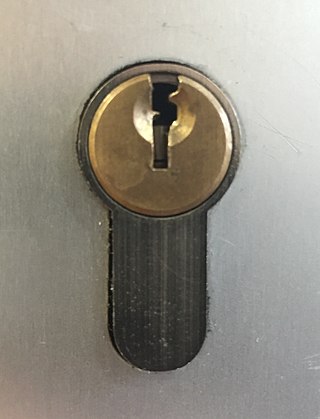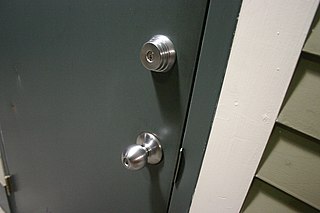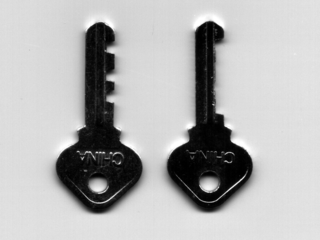
Gun safety is the study and practice of using, transporting, storing and disposing of firearms and ammunition, including the training of gun users, the design of weapons, and formal and informal regulation of gun production, distribution, and usage, for the purpose of avoiding unintentional injury, illness, or death. This includes mishaps like accidental discharge, negligent discharge, and firearm malfunctions, as well as secondary risks like hearing loss, lead poisoning from bullets, and pollution from other hazardous materials in propellants and cartridges. There were 47,000 unintentional firearm deaths worldwide in 2013.

Handcuffs are restraint devices designed to secure an individual's wrists in proximity to each other. They comprise two parts, linked together by a chain, a hinge, or rigid bar. Each cuff has a rotating arm which engages with a ratchet that prevents it from being opened once closed around a person's wrist. Without the key, the handcuffs cannot be removed without specialist knowledge, and the handcuffed person cannot move their wrists more than a few centimetres or inches apart, making many tasks difficult or impossible.

A hinge is a mechanical bearing that connects two solid objects, typically allowing only a limited angle of rotation between them. Two objects connected by an ideal hinge rotate relative to each other about a fixed axis of rotation, with all other translations or rotations prevented; thus a hinge has one degree of freedom. Hinges may be made of flexible material or moving components. In biology, many joints function as hinges, such as the elbow joint.

Bondage cuffs are restraints designed for use in sexual bondage situations. Compared to conventional handcuffs, they are wide wrist and ankle restraints generally made of leather, often padded with soft leather or fake fur. Bondage cuffs may be fastened at the wrists and/or ankles by a locking mechanism, by a buckle or by velcro. They are secured around the wrist or ankle, and the cuffs may then be attached to each other or another object.

The pin tumbler lock is a lock mechanism that uses pins of varying lengths to prevent the lock from opening without the correct key. Pin tumblers are most commonly employed in cylinder locks, but may also be found in tubular pin tumbler locks.

A lock is a mechanical or electronic fastening device that is released by a physical object, by supplying secret information, by a combination thereof, or it may only be able to be opened from one side, such as a door chain.

A safe is a secure lockable box used for securing valuable objects against theft or fire. A safe is usually a hollow cuboid or cylinder, with one face being removable or hinged to form a door. The body and door may be cast from metal or formed out of plastic through blow molding. Bank teller safes typically are secured to the counter, have a slit opening for dropping valuables into the safe without opening it, and a time-delay combination lock to foil thieves. One significant distinction between types of safes is whether the safe is secured to a wall or structure or if it can be moved around. A less secure version is usually called a cash-box.

A deadbolt or deadlock is a type of lock morticed into a wooden door. Then, using a key from either side of the door, a bolt is thrown into the door frame, thus securing the door. It is distinct from a spring bolt lock because a deadbolt can only be opened by a key or handle. The more common spring bolt lock uses a spring to hold the bolt in place, allowing retraction by applying force to the bolt itself. A deadbolt can therefore make a door more resistant to entry without the correct key, as well as make the door more resistant to forced entry. A deadbolt is often used to complement a spring-bolt lock on an entry door to a building.

A lever tumbler lock is a type of lock that uses a set of levers to prevent the bolt from moving in the lock. In the simplest form of these, lifting the tumbler above a certain height will allow the bolt to slide past.

Legcuffs are physical restraints used on the ankles of a person to allow walking only with a restricted stride and to prevent running and effective physical resistance. Frequently used alternative terms are leg cuffs, (leg/ankle) shackles, footcuffs, fetters or leg irons. The term "fetter" shares a root with the word "foot".

Safe-cracking is the process of opening a safe without either the combination or the key.

Plastic handcuffs are a form of physical restraint for the hands made of plastic straps. They function as handcuffs but are cheaper and easier to carry than metal handcuffs, and they cannot be reused. The device was first introduced in 1965.

A bicycle lock is a security device used to deter bicycle theft, either by simply locking one of the wheels or by fastening the bicycle to a fixed object, e.g., a bike rack.

A latch or catch is a type of mechanical fastener that joins two objects or surfaces while allowing for their regular separation. A latch typically engages another piece of hardware on the other mounting surface. Depending upon the type and design of the latch, this engaged bit of hardware may be known as a keeper or strike.

A skeleton key is a type of master key in which the serrated edge has been removed in such a way that it can open numerous locks, most commonly the warded lock. The term derives from the fact that the key has been reduced to its essential parts.

Speedcuffs are a model of handcuff characterised by their rigid grip between the two ratchet cuffs. Their rigid design and the inclusion of a grip makes them effective for gaining control over a struggling prisoner, even if only one cuff has been applied. They are standard issue for most police forces within the United Kingdom. Amnesty International has criticised the handcuffs, claiming that implements made by the company have been used around the world to torture prisoners.

A police duty belt is a belt, typically constructed of nylon or leather used by police, prison and security officers to carry equipment easily in a series of pouches attached to the belt, in a readily-accessible manner, while leaving the hands free to interact. This belt can carry any number of useful items, ranging from handcuffs to guns.

A computer keyboard is a peripheral input device modeled after the typewriter keyboard which uses an arrangement of buttons or keys to act as mechanical levers or electronic switches. Replacing early punched cards and paper tape technology, interaction via teleprinter-style keyboards have been the main input method for computers since the 1970s, supplemented by the computer mouse since the 1980s.
A belly chain is a physical restraint worn by prisoners, consisting of a chain around the waist, to which the prisoner's hands may be chained or cuffed. Sometimes the ankles are also connected by means of longer chains.

A handcuff cover is a piece of plastic or metal that can be placed around a pair of handcuffs. It consists of a hinged, box-like assembly locked over the handcuff chain, wristlets and keyholes.



















